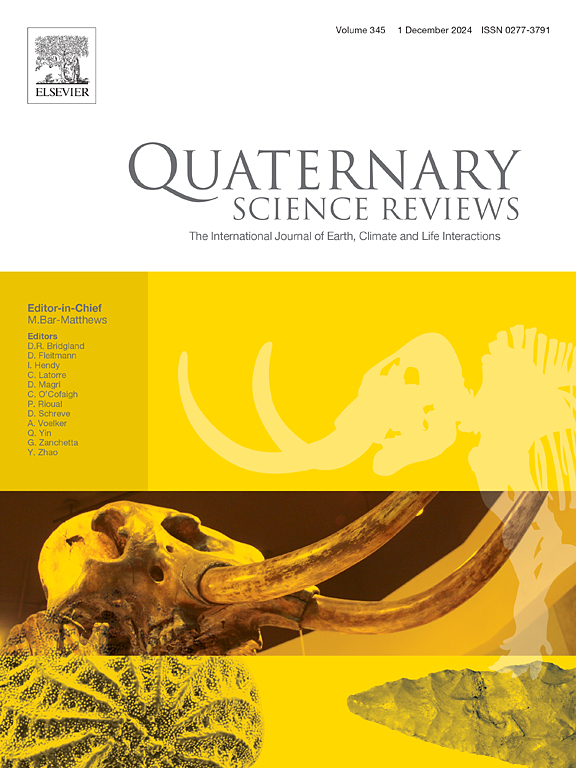罗马时期欧洲南阿尔卑斯低地震活动区的强震——湖相古地震评价
IF 3.3
1区 地球科学
Q1 GEOGRAPHY, PHYSICAL
引用次数: 0
摘要
中强震危险性评价(矩震级,MW >;5.5)在缓慢变形的地区,如欧洲南阿尔卑斯山,由于重复周期超过历史记录所覆盖的时间范围,以及缺乏揭示震源参数的古地震数据,阻碍了地震的发展。一个地区最大可能震级(Mmax)的估计通常仅仅基于理论模型,缺乏长期古地震记录的验证。根据一项考古地震研究,一个罕见的潜在Mmax事件是由发生在公元3世纪的同震地表破裂影响了意大利南蒂罗尔州埃格纳/诺伊马尔克特(Egna/Neumarkt)的罗马时代建筑形成的。我们的研究通过检查Kleiner Montiggler See/Piccolo Lago di Monticolo湖的沉积记录来验证这一假设,该湖距离埃格纳遗址仅10公里,以寻找地震震动的证据。对沉积物岩心的多代理分析使我们能够解开不同的沉积过程,并确定一个事件层,我们认为这是由地震地震引起的。使用基于放射性碳的年龄深度模型,该事件可追溯到公元222年(公元8-450年,95%概率范围),与确定的断层偏移相吻合,因此支持罗马时代埃尼亚地表破裂地震的假设。我们通过考虑Kleiner Montiggler See事件层的沉积特征、湖泊系统的震后反应以及更广泛地区其他强历史地震缺乏湖相沉积证据来约束本次地震的最小局地烈度。我们利用地面运动模拟,并与附近湖泊的古地震记录进行比较,评估了埃尼亚地震的不同潜在震级情景。这使我们可以推断,6.5兆赫是最可能的情景,这是一致的,略低于研究区域的最大估计。这一在构造域内靠近假定的最大震区的强震的经验证据突出了在明显的低地震活动区域未被识别的发震构造所造成的潜在危险。这强调了在这些地区需要长期的古地震记录来完善对强震的危险性评估。本文章由计算机程序翻译,如有差异,请以英文原文为准。
Strong earthquake in a low seismicity area of the European Southern Alps during Roman Times – A lacustrine paleoseismic evaluation
Hazard assessment of moderate to strong earthquakes (moment magnitude, MW > 5.5) in slowly deforming regions, such as the European Southern Alps, is hindered by recurrence intervals that exceed the timeframe covered by historical records and a lack of paleoseismic data revealing earthquake source parameters. Estimations of the maximum possible magnitude (Mmax) in a region are often solely based on theoretical models and lack validation by long paleoseismic records. A rare example of a potential Mmax event is formed by a coseismic surface rupture impacting a Roman age building in Egna/Neumarkt (South Tyrol, Italy) which occurred during the 3rd century CE, as proposed by an archaeoseismological study. Our study tests this hypothesis by examining the sedimentary record of Kleiner Montiggler See/Piccolo Lago di Monticolo, a lake located only 10 km from the Egna site, for evidence of seismic shaking. A multiproxy analysis of sediment cores allowed us to disentangle different depositional processes and to identify an event layer, which we interpret to be caused by a seismic seiche. Using a radiocarbon-based age-depth model, the event was dated to ∼222 years CE (8–450 years CE, 95 % probability range), coinciding with the identified fault offset, and therefore supporting the hypothesis of a Roman Age surface rupturing earthquake in Egna. We constrain the minimum local intensity of this earthquake by considering the sedimentary characteristics of the event layer in Kleiner Montiggler See, the post-seismic response of the lake system, and the absence of lacustrine sedimentary evidence for other strong historical earthquakes in the broader region. We evaluate different potential magnitude scenarios for the Egna earthquake by using ground motion modelling and comparing the results with paleoseismic records from nearby lakes. This allows us to infer that an MW of 6.5 is the most likely scenario for this event, which is consistent and slightly below the Mmax estimates for the study area. This empirical evidence for a strong earthquake close to the considered Mmax within its tectonic domain highlights the potential hazard posed by unrecognized seismogenic structures in regions with apparent low seismic activity. This emphasizes the need for long paleoseismic records in such regions to refine hazard assessment of strong earthquakes.
求助全文
通过发布文献求助,成功后即可免费获取论文全文。
去求助
来源期刊

Quaternary Science Reviews
地学-地球科学综合
CiteScore
7.50
自引率
15.00%
发文量
388
审稿时长
3 months
期刊介绍:
Quaternary Science Reviews caters for all aspects of Quaternary science, and includes, for example, geology, geomorphology, geography, archaeology, soil science, palaeobotany, palaeontology, palaeoclimatology and the full range of applicable dating methods. The dividing line between what constitutes the review paper and one which contains new original data is not easy to establish, so QSR also publishes papers with new data especially if these perform a review function. All the Quaternary sciences are changing rapidly and subject to re-evaluation as the pace of discovery quickens; thus the diverse but comprehensive role of Quaternary Science Reviews keeps readers abreast of the wider issues relating to new developments in the field.
 求助内容:
求助内容: 应助结果提醒方式:
应助结果提醒方式:


